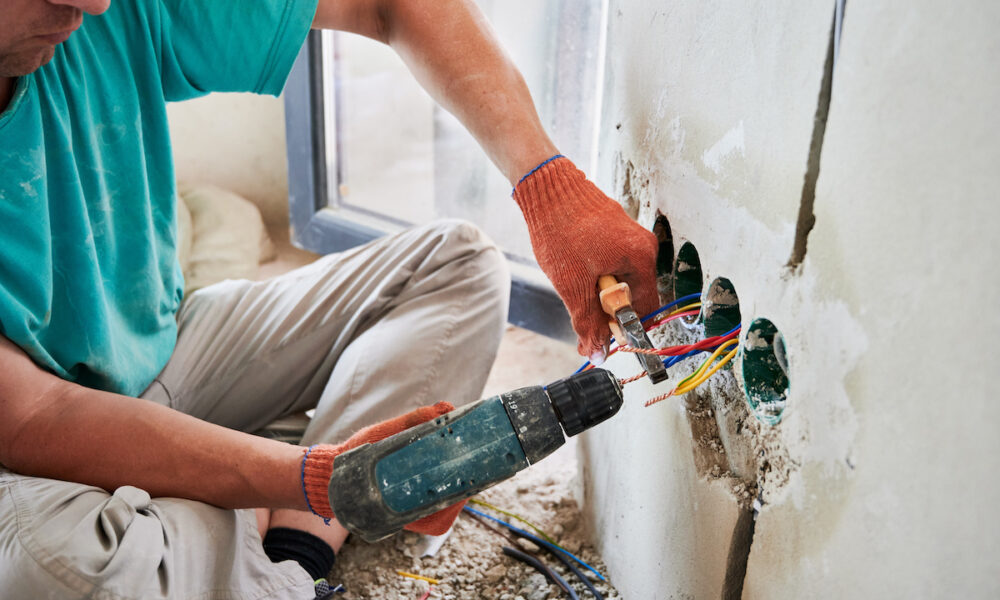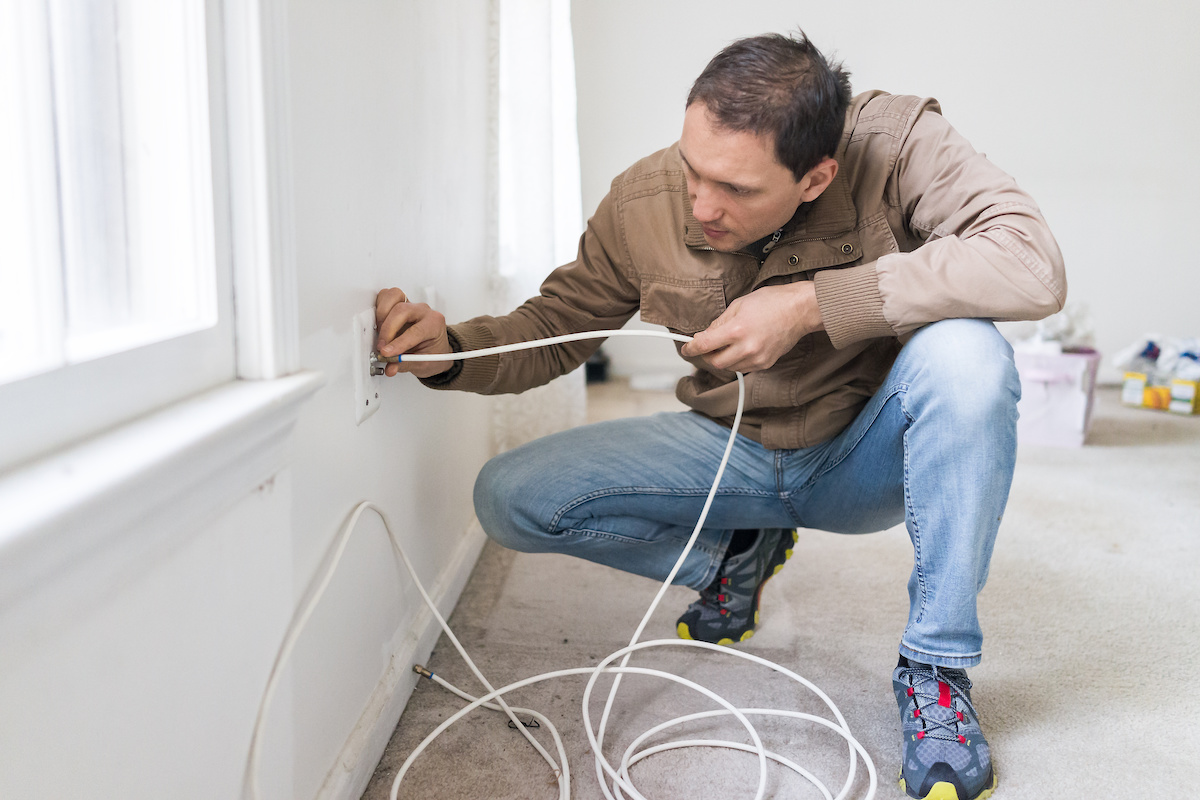
You have big dreams for your home remodel. Maybe you are envisioning new pendant lights over a kitchen island. You might have an idea to put beautiful sconces on each side of your bed for ambient lighting. No matter your dream, there are serious considerations to think about when it comes to electrical wiring for a home remodel.
Before you attempt your electrical wiring during your home remodel project, be sure to read the advice below. Always contact Dadz for help if you have any hesitation!
The Dos of Electrical Wiring for a Home Remodel
When embarking on a home remodel, electrical wiring is an essential aspect that demands attention and meticulous planning. Adhering to best practices during this process ensures the safety and functionality of your renovated space. Here’s a list of key dos to follow during the electrical wiring phase of your home remodel:
Plan and design thoroughly before starting
A well-thought-out blueprint for your remodel’s electrical wiring minimizes mistakes and ensures a smoother workflow. Make sure to plan the layout of outlets, switches, and fixtures before commencing the project.
Example of Planning and Designing a Home Remodel Wiring Project
One of the primary considerations is to ensure that the wiring is up to code and meets all safety standards. This involves evaluating the existing wiring and assessing the electrical load requirements for the new remodel. It is important to consider the number of outlets and circuits needed to support the electrical needs of the remodel.
Here are some additional key considerations when planning and designing a home remodel wiring project:
- Assess the existing wiring and determine if any upgrades or replacements are necessary to meet code requirements.
- Evaluate the electrical load requirements of the remodel, including the power needs of any new appliances, lighting fixtures, and outlets.
- Consider the placement of switches, outlets, and light fixtures to optimize functionality and convenience.
- Determine the number of circuits and outlets needed to support the electrical demands of the remodel.
- Identify any potential hazards or safety concerns, such as overloaded circuits or exposed wires, and take steps to mitigate these risks.
- Work with a licensed electrician to ensure that the project is safe, up to code, and on budget.
Hire a licensed electrician
Engaging the services of a licensed electrician ensures that your remodel adheres to local codes and safety standards. Meanwhile, a professional will provide expert guidance on your project. You can also dramatically improve the success and safety of your process with the help of a professional. Here at Dadz, we are here to help make your dream home remodel a reality. When you need a hand, contact us for an appointment.
Choose the right materials and tools
Investing in high-quality materials and tools is crucial for the longevity and safety of your electrical system. Opt for reputable brands and seek advice from your electrician to make informed decisions.
Important electrical tools for a successful home remodel project
Proper electrical tools are essential to ensure that the wiring is installed safely and efficiently. Here are some essential electrical tools that are necessary for a successful home remodel rewiring project:
- Wire Strippers and Cutters: These tools are essential for stripping and cutting wires for the correct length and size.
- Voltage Tester: A voltage tester is necessary to check whether an electrical circuit is live or not. This tool helps to ensure that the electrical work is safe, preventing the risk of electrocution.
- Fish Tape: A fish tape is a tool that pulls wires through walls, conduits, and other tight spaces. This tool makes it easy to run wires through challenging spaces, making it an essential tool for any electrical project.
- Circuit Tester: A circuit tester is a handy tool that tests circuits for continuity and ensures that they connect properly. It can help identify any faults in the wiring, which can prevent serious problems down the line.
- Wire Nuts and Connectors: These small components are necessary for connecting wires together safely and securely. They come in various sizes, and it is important to use the right size for the job to ensure proper connectivity.
- Electrical Tape: Electrical tape is essential for insulating and protecting wires from moisture and corrosion. It can also be used to indicate which wires are hot, neutral, or ground, which is crucial for safe and proper wiring.
- Conduit Bender: A conduit bender is necessary for bending metal conduit pipes to the proper angle. It is crucial to have the right angle to prevent sharp turns in the wiring, which can lead to kinks and damaged wires.
- Power Drill: A power drill is a tool for installing outlets and switches. It makes it easier to drill through walls and other materials, saving time and effort.
Install ground fault circuit interrupters (GFCIs) in appropriate areas
A GCFI, or Ground Fault Circuit Interrupter, is usually in electrical outlets located near water sources to prevent electric shock. It works by detecting when an electrical current is flowing through an unintended path. This includes flowing through water or a person’s body. It prevents these situations by quickly shutting off the power to the outlet. GCFIs are especially important in areas such as bathrooms, kitchens, and outdoor locations where water and electricity are commonly used together.
Ensure proper labeling and organization of wires
Accurate and clear labeling of wires streamlines the installation process and future maintenance efforts. Organized wiring reduces the risk of accidents and makes it easier to identify and troubleshoot issues.

The Don’ts of Electrical Wiring for a Home Remodel
While focusing on the dos of electrical wiring for a home remodel is crucial, it’s equally important to be aware of the pitfalls to avoid. Steering clear of these common mistakes will ensure the safety, efficiency, and longevity of your electrical system.
Here’s a list of key don’ts to keep in mind during the electrical wiring phase of your home remodel:
Don’t overload circuits with too many appliances or devices
Overloading circuits can lead to tripped breakers, blown fuses, or even electrical fires. Always be mindful of your circuit’s capacity and distribute electrical loads accordingly to avoid potential hazards.
What are the signs of overloaded circuits?
- Flickering or dimming lights: When lights flicker or dim for no apparent reason, it is a sign that the circuit is overloaded and struggling to keep up with the electrical demand.
- Tripped circuit breakers or blown fuses: If a circuit breaker or fuse trips frequently, the circuit may be overloaded.
- Buzzing or humming sounds: Electrical circuits that are overloaded can produce a buzzing or humming sound, especially from outlets or appliances that are drawing more power than the circuit can handle.
- Burning smell or discoloration: Overloaded circuits can cause electrical wires or components to overheat. This results in a burning smell or discoloration of the outlet or switch plate.
- Outlets that don’t work: Overloaded circuits can cause outlets to stop working, especially if the circuit is tripped frequently or if the wiring is damaged or worn.
Don’t attempt DIY electrical work without proper training or experience
While it may be tempting to save money by doing your own electrical work, this can result in serious consequences if you lack the necessary skills and knowledge. Always enlist the help of a licensed electrician to ensure the job is done safely and correctly.
Don’t ignore warning signs of electrical issues
Be vigilant for indications of potential problems, such as flickering lights, warm outlets, or unusual smells. Address these warning signs immediately by consulting a professional electrician. This is key to preventing more severe issues down the line.
Don’t cut corners with materials or installations
Skimping on materials or installations can lead to costly repairs or even dangerous situations. Invest in high-quality materials and hire a reputable electrician to ensure your electrical system remains safe and reliable.
Let Dadz Handle Your Electrical Wiring for a Home Remodel
If you have big dreams for your home remodeling project, don’t attempt electrical wiring on your home. We are the pros at electrical wiring for a home remodel with 30+ years of experience. Contact us today to schedule an appointment.
If you own a rental property, check out this article for expert advice on electrical and other essential property upkeep tips.